|
|
||||||||||
|
|
|
|
|
|
||||||
|
|
||||||||||

Environmental Science:
Aquaculture
Aquatic Invasive Species
Biodiversity Science
Freshwater Science
Habitat Science
Oceans Integrated Management
Science Information By:
Aquatic Invasive Species
An aquatic invader is a non-native species, whose introduction will
likely cause (or has already caused) damage to the host ecosystem, existing
species therein, the economy or human well-being. Invasive species thrive in
the absence of their native predators and have the potential to drastically
alter habitat, rendering it inhospitable for native species.
Aquatic invasive species (AIS) have already been responsible for significant
devastation of some native fish species and fisheries in Canada. Annually,
the problem is responsible for billions of dollars in lost revenue and
control measures. Canada, with its huge freshwater resource and extensive
coastline, is especially vulnerable to this threat. The Environmental
Science knowledge base and scientific resources play an invaluable advisory
role to the government in its goal to address the problem. As an example, we
have provided scientific advice on alternate ballast water exchange zones.
(Ballast water contained on international ships is a major pathway by which
invasive species can enter Canadian waters.) The work done by Environmental
Science has facilitated Transport Canada's proposed revisions of the Canada
Shipping Act Ballast Water Regulations.
You can read about Canada's plan to address aquatic invasive species at:
Examples of aquatic invasive species found in Canadian waters:
Sea lamprey were a significant factor in the collapse of the lake
trout and whitefish fisheries in the 1940’s & 1950’s. The Sea Lamprey
Control Program, implemented in 1955, resulted in a 90% reduction in sea
lamprey populations.
Sea lamprey is a primitive eel-like fish that feed on the body fluids of
other fish by clinging by their mouth and goring though the scales and skin
with their tongue. They prey on all species of large fish in the Great
Lakes.
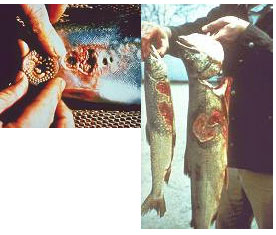
Zebra mussels are small freshwater molluscs introduced to North
America in the mid-1980s via ballast water from transoceanic vessels.
They have since spread rapidly to all of the Great Lakes and inland
waterways in the United States and Canada causing millions of dollars in
damage annually to human infrastructure.
Their feeding causes an increase in water clarity in the Great Lakes which,
in turn, results in increased light penetration and an overgrowth of
vegetation and toxic algal blooms.
They colonize on a variety of surfaces, such as docks, boat hulls, fishing
nets, pipes, etc. The photos show zebra mussels growing on a golf ball and a
boat.
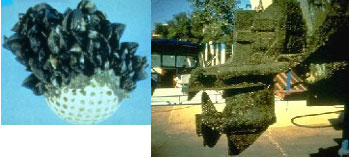
Green crabs eat a variety of native East Coast clams, mussels and
oysters, and threatens West Coast shellfish. The small shore crab is an
efficient predator and colonizer.
It has invaded numerous coastal communities outside of its native range,
including South Africa, Australia, and the Pacific & Atlantic coasts of N.
America.
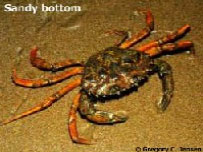
Clubbed tunicate interfere with the settlement of oyster and
mussel larvae and compete for space and food with young native oysters and
mussels.
Here, the photo shows tunicates growing on mussel lines.
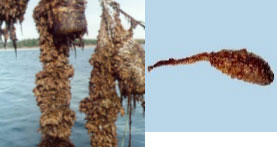
Japanese oyster drills will bore holes into young oysters and feed
on them. They do not inherently migrate, however still managed to cause
significant damage to the oyster industry until they were brought under
control in the 1990’s.
(Photo credited to the Washington Department of Fish and Wildlife.)
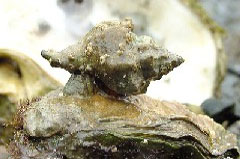
Round Gobys have spread rapidly within the Great Lakes since their
discovery in 1990. They are very competitive and populate quite easily. In
addition to habitat domination, they will also eat the eggs and the young of
indigenous fish. It is presumed that they arrived via the ballast water of
transoceanic vessels.
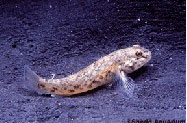
Rusty Crayfish are more aggressive than the native freshwater crayfish. They can consume the eggs and young of surrounding fish. They are also quite devastating to native aquatic plant life, on which they feed. Rusty crayfish will displace and/or hybridize with native crayfish.
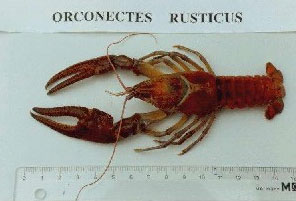
Spiny and Fishhook Waterfleas are small crustaceans. The spiny
water fleas were first discovered in the early 1980's in the great lakes and
the fishhook variety, later, in the late 1990's. They damage fishing gear
and compete with native fish for food . They collect on fishing lines and
cables, clogging rods and damaging reels.
Asian carp will compete for food with indigenous species and prey on their larvae. They can also cause significant habitat damage and ecological disruption. Moreover, Asian Silver carp tend to jump out of the water and endanger recreational boaters and water skiers. Asian carp have become a serious problem in US waterways, and have the potential to invade Canadian freshwaters. With the support of DFO, proactive efforts are underway to reduce the likelihood of Asian carp species becoming established in Canada. Fishers are urged to keep a watch for Asian carp in Canadian waters!

You can read more about the risks of Asian Carp in the CSAS document: